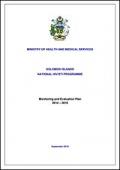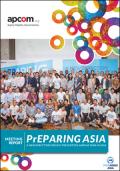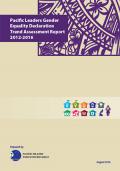What's New
Displaying results 2511 - 2520 of 4914

Resource | Publications,
This M&E Plan is purposed to enable the National HIV/STI Programme to work more effectively and efficiently to:
- Gather the information needed to guide the planning, coordination, and implementation of the national HIV response
- Assess the effectiveness of the HIV response
- Identify areas for programme improvement
- Ensure accountability to those providing financial resources for the HIV response.
- Provide a communication tool that outlines various roles and responsibilities regarding monitoring and evaluation for the National HIV/STI program.
- Organize plans for data collection, analysis, use, and data quality.
- Outline specific strategies and tools to encourage informed decision-making.
- Organize the numerous M&E activities that are necessary for the successful operation of a national M&E system.
- Engage stakeholders outside of the national government to ensure an integrated and harmonized M&E system.

Resource | Fact Sheets,
HIV-associated TB presents a risk to achieving the Sustainable Development Goals. Effective, sustained action is required to meet the needs of the most vulnerable populations.
United Nations Member States have committed to work towards the target of reducing deaths related to tuberculosis (TB) among people living with HIV by 75% by 2020, as well as reaching 90% of all people with TB with preventive or therapeutic treatment and achieving 90% treatment success for all people diagnosed with TB.
The commitments from Member States must be bold and ambitious and leaders of Member States must be held accountable for their actions in taking urgent steps to end two of the worlds leading infectious diseases, TB and HIV.

Resource | Publications,
Organized by APCOM with the support from UNAIDS and WHO, the dialogue brought in representatives of gay identified men, other men who have sex with men (MSM), sexual health policy makers, program planners and service providers and explore the potential of scaling up PrEP. Conducted in Amari Watergate, Bangkok, from 23 to 25 September 2015, the Dialogue was part of the regional rolling out of the new WHO Guidelines, which recommend PrEP as an important additional component of comprehensive HIV prevention for high risk MSM.

Resource | Guidelines,
This document is an update of guidance published on 7 June 2016 to provide advice on the prevention of sexual transmission of Zika virus.
The primary transmission route of Zika virus is via the Aedes mosquito. However, mounting evidence has shown that sexual transmission of Zika virus is possible and more common than previously assumed.1 This is of concern due to an association between Zika virus infection and adverse pregnancy and fetal outcomes, including microcephaly, neurological complications and Guillain-Barré syndrome.

Resource | Infographics,
PrEP works if you take it. The figures on this graphic show the relationship between PrEP efficacy and adherence and the status of regulatory action on PrEP worldwide. It also shows other potential new formulations of ARV-based prevention being evaluated as additional options in the future.

Resource | Publications,
This 2015, the Epidemiology Bureau of the Department of Health (DOH-EB), together with various partners conducted several activities with the goal of updating the size estimates of key affected populations (KAP) in the Philippines, specifically among males who have sex with males (MSM), female sex workers (FSW) and injecting drug users (IDU).
With these updated information, the DOH-EB aims to guide the national, regional, and local HIV program to set appropriate targets for the provision and monitoring of services specific for these key affected populations in different parts of the country.

Resource | Publications,
The 10th Asia-Pacific United Nations Prevention of Parent-To-Child Transmission (PPTCT) of HIV and Syphilis Task Force meeting was held from 15 to 17 September 2015 in Beijing, China. More than 230 participants from 19 Asia-Pacific countries, including 90 participants from provinces in China, as well as civil society and United Nations partners attended the meeting. The meeting focused on steps towards achieving and validating the elimination of parent-to-child transmission (EPTCT) of infectious diseases, and the integration of services to contribute to improving maternal and child health (MCH) outcomes.

Resource | Publications,
The primary purpose of this Report is to motivate action and accountability, by reviewing commitments made and assessing areas of strength and weaknesses of implementation, in the context of the Pacific Leaders Gender Equality Declaration(PLGED).
The Report is outlined as follows: Part 2 provides a brief summary of the Pacific's PLGED progress; Part 3 takes a closer look at national level progress; and Part 4 highlights key recommendations towards accelerating the six priority areas, drawing from regional and national experience.

Resource | Publications,
kNOwVAWdata is a UNFPA initiative to support and strengthen sustainable regional and national capacity to measure violence against women (VAW). Over three-and-a-half years, from mid-2016 through the end of 2019, with support from the Australian Department of Foreign Affairs and Trade (DFAT), the kNOwVAWdata initiative will build on work already being supported by UNFPA to conduct VAW surveys and analysis in in the Asia-Pacific region. The initiative will also ensure sustainability, including by strengthening capacities of national institutions to collect and analyze data, in particular by using internationally recognized, best practice survey methodologies.

Resource | Publications,
'kNOwVAWdata is a UNFPA initiative to support and strengthen sustainable regional and national capacity to measure VAW. Over three-and-a-half years, from mid-2016 through the end of 2019, with support from the Australian Department of Foreign Affairs and Trade (DFAT), the kNOwVAWdata initiative will build on work already being supported by UNFPA to conduct VAW surveys and analysis in in the Asia-Pacific region. The initiative will also ensure sustainability, including by strengthening capacities of national institutions to collect and analyze data, in particular by using internationally recognized, best practice survey methodologies.





